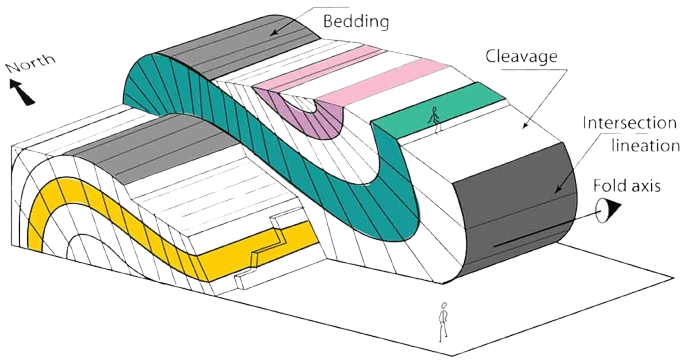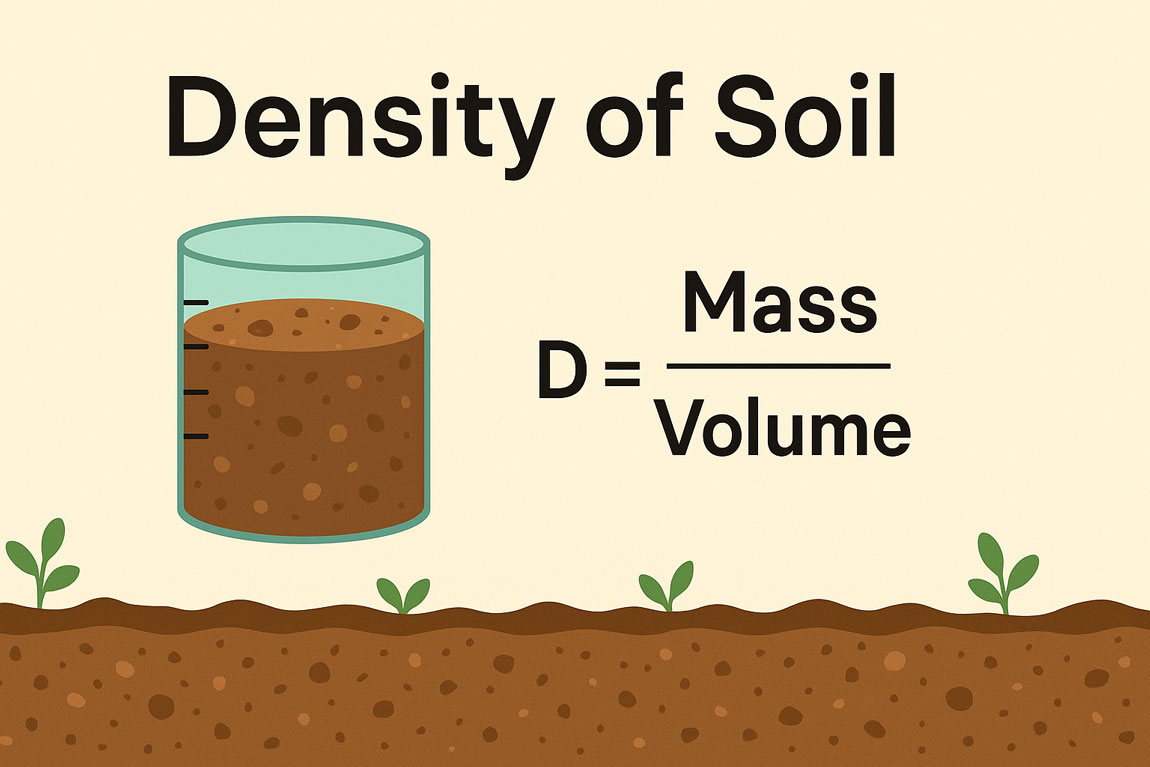Lineation:
Lineation is expressed by the parallelism of some directional property in the rock.
Types of lineation:
Lineation is found to develop in igneous, sedimentary, and metamorphic rocks. Lineation is of two types:
- primary lineation (sedimentary rocks, igneous rocks)
- and secondary lineation (metamorphic rocks)
Primary Lineation:
Primary lineations are those formed during rock formation. They are found in sedimentary and igneous rocks. Some varieties found in sedimentary rocks may be used to tell the top and bottom of beds, some may be used to tell the direction of sediment transport, and some may be used for both purposes.
In igneous rocks, both intrusive and extrusive, it may be used to tell the direction in which magma or ash flows are moving.
Secondary Lineation:
Secondary lineations sometimes form in rocks after being deposited, erupted, or intruded. The time-lapse may be short or long. Moreover, secondary lineation may be imposed on rocks more than once so that several differently oriented lineations may be present in the rock.
All transitions exist between rocks with no lineation and rocks with excellent lineation. In one rock, the long axes of 90% of the hornblende crystals might be within a few degrees of each other; such a striking linear parallelism would be recognized immediately.
In another rock, however, the long axes of the hornblende crystals might be relatively evenly oriented in all possible directions within the rock; in such a case, no lineation would exist.
Secondary lineation may occur with or without foliation. A rock without cleavage or schistosity may possess lineation. More commonly, however, secondary lineation is associated with foliation and lies in the plane of the foliation.
Kinds of Secondary Lineation:
Lineation is of different kinds; these are as follows:
1. Lineation given by minor fold axes
2. Lineation given by elongated or stretched pebbles
3. Mineral lineation
4. Lineation given by corrugations or crinkles
5. Lineation given by the intersection of “S” planes:
6. Lineation given by slickensides
7. Lineation given by boudin’s line
8. Lineation given by quartz rod
9. Lineation given by mullion
Lineation given by minor fold axes:
Fold axes are commonly considered to be lineation. In metamorphic terrain, the fold axes of minor folds exhibit parallel arrangement. The attitude of the fold axes is often the reference to which other lineations are compared.
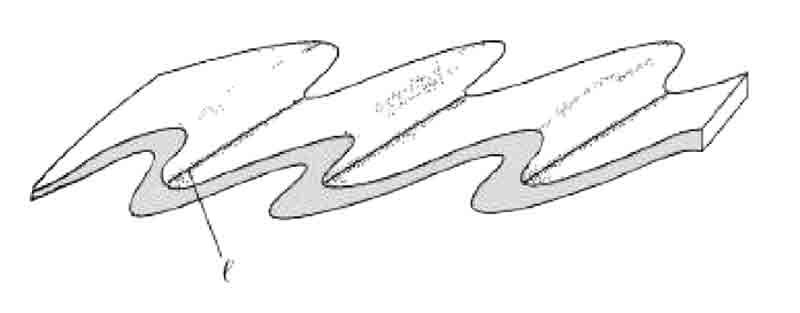
Lineation given by elongated or stretched pebbles:
Elongated or stretched pebbles, which are irregular ellipsoids, are associated with a foliation. The shortest axes of the pebbles are perpendicular to this foliation. The intermediate and long axes lie in the plane of foliation. The parallelism of the long axes of the pebbles produces the lineation.
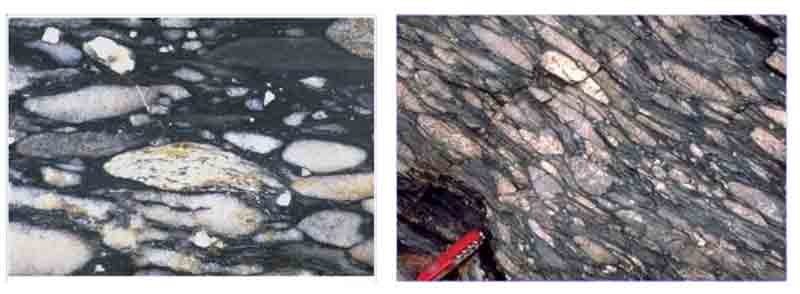
Mineral lineation:
Parallel linear orientation of individual minerals is very common in deformed metamorphic rocks. Lineation of this type are usually called mineral lineations. Lineation is more commonly expressed by the minerals constituting the rock.
Hornblende crystals, which have one long dimension, with the result that individual crystals are more or less needle–shaped, may display an excellent lineation. In some instances, biotite occurs as elliptical plates, the long axes of which are parallel. In other cases, an original, more or less spherical mineral may be granulated into numerous fragments, which become strung out into an ellipsoidal group.

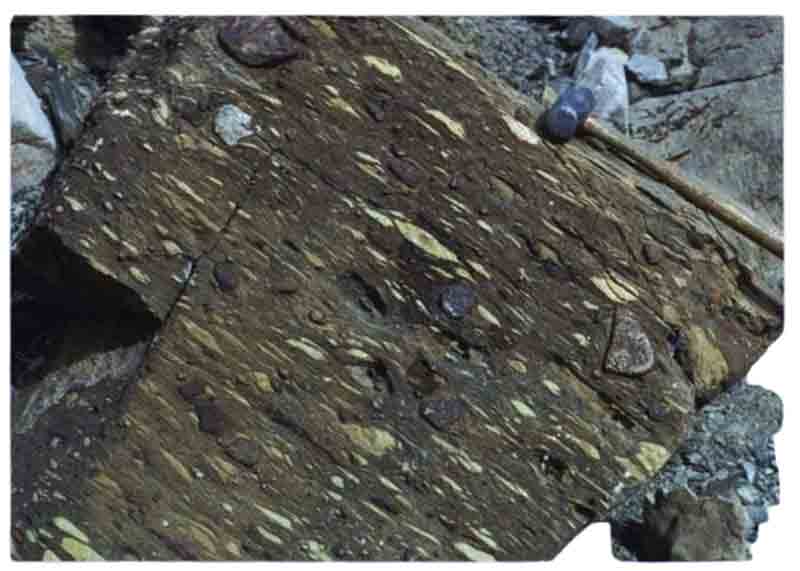
Lineation given by corrugations or crinkles:
The schistosity or cleavage may be thrown into small corrugations or crinkles, with wavelength and amplitude measured in millimeters. The axes of the crinkles give the lineation.

Lineation given by the intersection of “S” planes:
The intersection of different “S” planes produces a lineation because the intersection of two planes is a line. If the rock breaks parallel to the cleavage, the trace of the bedding appears as parallel streaks on the cleavage plane.

Lineation given by slickensides:
Slickensides are a type of lineation. In some cases, the scratches may be very obvious and clearly indicate the direction of movement. At other places, streaking caused by the concentration of dark minerals along certain lines may be caused by the sliding of layers past one another.
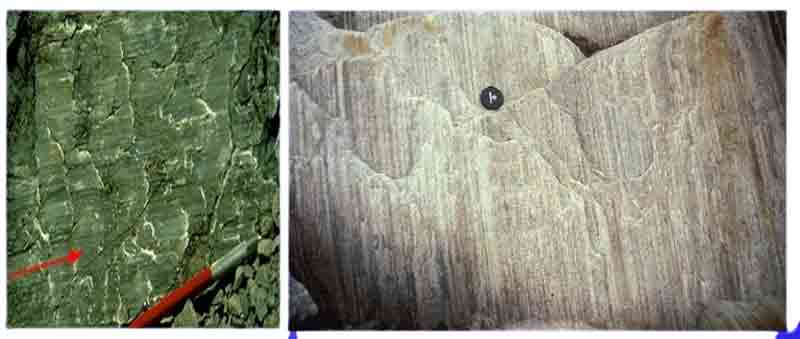
Lineation given by Boudin’s line:
Boudinage, or sausage structure, results from stretching a competent bed that thickens and thins to simulate a string of sausages. Parallel to the bedding, the individual units look like sausages lying side by side. The line of junction of the individual units is called the boudin line and is a lineation.
Quartz, feldspar, or some other mineral may occupy the boudin line. Boudinage is the result of stretching at right angles to the boudin line. The more brittle bed shows boudinage.

Lineation given by quartz rod:
Quartz rods are found in some areas of metamorphosed rocks. In their extreme development, they are long cylindrical rods of quartz. A complete study of their evolution shows that in their simplest form, they are small concordant veins of quartz that may have been derived from silica secreted from the country rock.
However, as the individual veins become more irregular and discontinuous, they assume forms unlike boudins but far more irregular; many are rod-like.
Lineation given by mullion:
A mullion structure consists of a series of parallel columns. Each column may be several inches in diameter and several feet long and is composed of folded sedimentary or metamorphic rocks.
Attitude:
The attitude of lineation is measured by its bearing and plunge or inclination. The bearing is the azimuth of the horizontal projection of the lineation, whereas the plunge is the angle between the horizontal line and lineation measured in the vertical plane.
The symbols for lineation may be shown independently of foliation or bedding. It may also be shown in combination with bedding or foliation symbols. Lowercase letters may be used to indicate the kind of lineation, such as p for pebble, h for hornblende, c for crinkles, etc.


